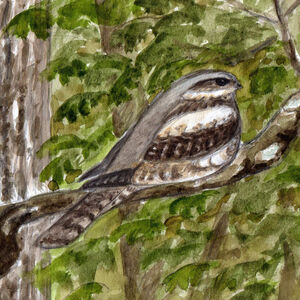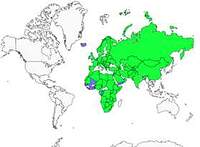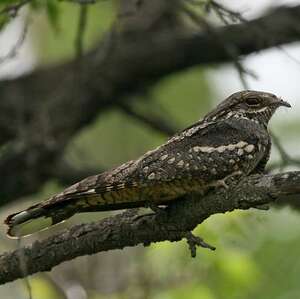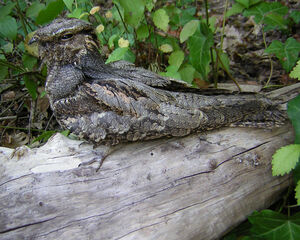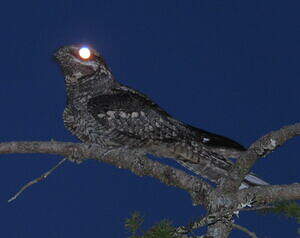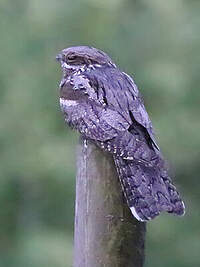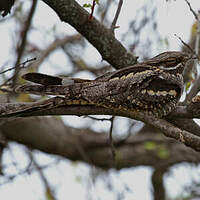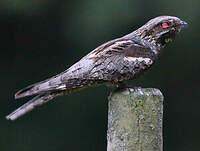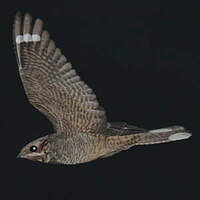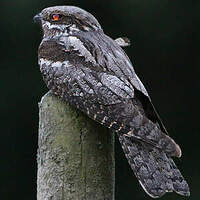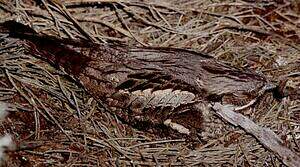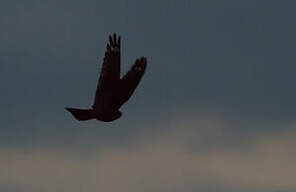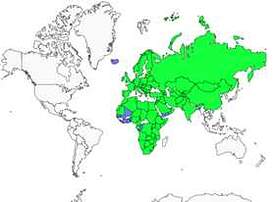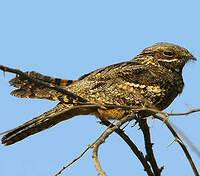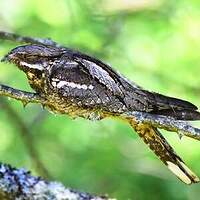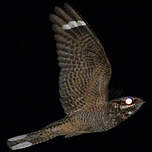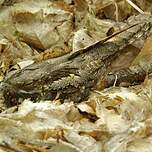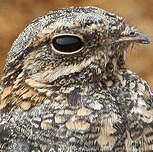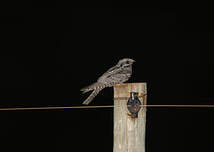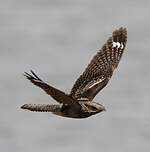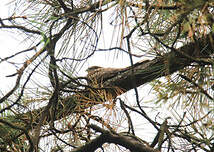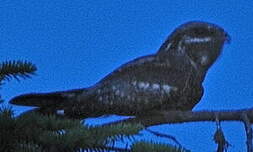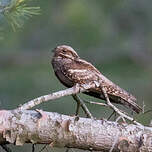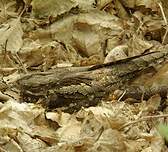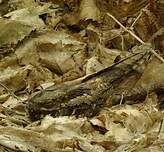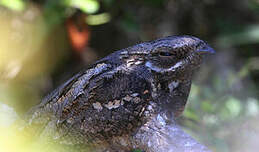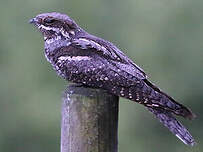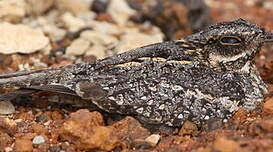European Nightjar
Caprimulgus europaeus - Engoulevent d'Europe
Identification
Due to its habitat and its crepuscular and nocturnal activity, the European Nightjar is not at all easy to observe. Most of the time, it is a silhouette moving against the pale background of a setting sun sky that you can have the chance to observe. To be able to detail the bird, you either have to be lucky enough to find it during the day perched motionless on its day perch, but this chance is very slim, or capture it with the net in view of the ringing and have it in hand. At first glance, one is struck by its dead leaves and bark colour plumage, striped and barred, a bit like a night raptor, which ensures it effective camouflage when it is perched on the ground or on a branch. Rather than a long and confusing description, it is better to have a photo of the bird, for example this one: https://www.oiseaux.net/photos /frederic.pelsy/engoulevent.d.europe.3.html#espece to judge its cryptic plumage. The large eye is typical of a night hunter. On the other hand, the beak is very small, which means that it has only a secondary role. The major role is played by the very large opening of the buccal cavity which is able to swallow insects in flight. Finally, the very small legs are those of a high-flying hunter, which is not suitable for walking. There is a visible sexual dimorphism in flight. The male shows white spots at the end of its wings and at the corners of its tail, marks which the female does not have. In flight, its silhouette resembles a giant swallow rather than a large swallow, although it is systematically closer to the latter.
Subspecific information 6 subspecies
- Caprimulgus europaeus europaeus (c and n Europe to c, n and sc Siberia)
- Caprimulgus europaeus meridionalis (s Europe and n Africa to the Caucasus and nw Iran)
- Caprimulgus europaeus sarudnyi (Kazakhstan and w Siberia)
- Caprimulgus europaeus unwini (Iraq and Iran to Turkmenistan and Uzbekistan)
- Caprimulgus europaeus plumipes (nw China to w and s Mongolia)
- Caprimulgus europaeus dementievi (ne Mongolia to sc Siberia)
Foreign names
- Engoulevent d'Europe,
- Chotacabras europeo,
- noitibó-europeu,
- Nachtschwalbe,
- lappantyú,
- Nachtzwaluw,
- Succiacapre,
- nattskärra,
- Nattravn,
- lelek lesný,
- lelek lesní,
- Natravn,
- kehrääjä,
- Europese Naguil,
- enganyapastors comú,
- Náttfari,
- lelek (zwyczajny),
- vakarlēpis,
- podhujka,
- Козодой,
- ヨーロッパヨタカ,
- 欧夜鹰,
- 歐夜鷹,
Voice song and call
At the time of installation, pair formation and the start of reproduction, the male will defend its territory with its voice. Its song is a warbling type Locustella, but with a tone in proportion to its size. It is a powerful trill, made of liquid and percussive notes, which can be heard from a few hundred meters, or even a kilometer away. It is sung at dusk from a perch and can last for several minutes. Very often, the song is followed by a sound of wings flapping as the male takes flight. The vocal repertoire is rather rich in flight calls, particularly loud houit or kek kek kek series, and tjouk tjouk tjouk. Other calls can be heard during interactions between individuals or from fledglings outside the nest.
Habitat
On its breeding grounds, the European Nightjar looks for open woodlands in plain and moderate mountain areas, whether deciduous or coniferous. It is important that it can move freely between the trees, so it can be found in the old and young stages of regular stands, large clearings, regeneration, young conifer plantations in the plain, boggy woods and heathlands, shrubland in rocky hills, wooded dunes and even in tranquil industrial areas with trees and bushes.
Behaviour character trait
The European Nightjar is an insectivorous crepuscular and nocturnal bird. It spends the day resting either on the ground or on a branch.
It is not a timid bird. It relies on its homochromatic plumage with the environment to go unnoticed and it is indeed very difficult to observe when perched. When it lands on a branch, it is usually in the direction of its length. Then it can easily be mistaken for a broken branch if you are lucky enough to come across it. When it hunts at night above a still warm road, it can easily become a victim of car traffic, dazzled by headlights.Flight
Dietfeeding habits
Reproduction nesting
The European Nightjar pair often frequents the same spot each year. They usually arrive in mid-May. Upon arrival, the male parades above the female, wings and tail widely outstretched in order to display its brilliant white spots.
He also raises and snaps his wings to produce a sound resembling a whip crack. By the end of May, the female lays two creamy-white eggs with brown and gray marbling. There is no nest and the eggs are just laid in the ground. The two adults alternate night-time incubation so that each may hunt, but the female incubates alone during the day. The male incubates mostly at dawn and dusk to allow his mate to be away. The eggs hatch after 18 days and the chicks are fed insects by both parents. However, the male can do it alone if the female is busy with another clutch. The young are precocious and begin leaving the nest after a week. At 17 or 18 days old, they are able to fly and soon, they are ready to embark on the long migration to Africa.Geographic range
The European Nightjar is widespread from the British Isles and the Iberian Peninsula to the west to Mongolia and southern China to the east. In terms of latitude, it extends a little beyond 60°N in Scandinavia and southwards, inhabiting the Maghreb and the Middle East. It winters in Africa south of the Sahara, each subspecies having its own preferred wintering grounds.
Threats - protection
IUCN conservation status
concern
in the Wild
threatened
evaluated
Many threats hang over the species, particularly in modern countries like ours, modifications of its habitat, changes in forestry techniques and crop rotation, use of pesticides that reduce the availability of insects, collisions with automobiles, etc. for the European Nightjar.
Sources of information
- IOC World Bird List (v14.2), Gill, F and D Donsker (Eds). 2024-04-18.
Other sources of interest
 Specification sheet created on
16/07/2023 by Jean François
Specification sheet created on
16/07/2023 by Jean FrançoisTranslation by AI Oiseaux.net
© 1996-2025 Oiseaux.net
- Accipitriformes
- Aegotheliformes
- Anseriformes
- Apodiformes
- Apterygiformes
- Bucerotiformes
- Caprimulgiformes
- Cariamiformes
- Casuariiformes
- Charadriiformes
- Ciconiiformes
- Coliiformes
- Columbiformes
- Coraciiformes
- Cuculiformes
- Eurypygiformes
- Falconiformes
- Galliformes
- Gaviiformes
- Gruiformes
- Leptosomiformes
- Mesitornithiformes
- Musophagiformes
- Nyctibiiformes
- Opisthocomiformes
- Otidiformes
- Passeriformes
- Pelecaniformes
- Phaethontiformes
- Phoenicopteriformes
- Piciformes
- Podargiformes
- Podicipediformes
- Procellariiformes
- Psittaciformes
- Pterocliformes
- Rheiformes
- Sphenisciformes
- Steatornithiformes
- Strigiformes
- Struthioniformes
- Suliformes
- Tinamiformes
- Trogoniformes

